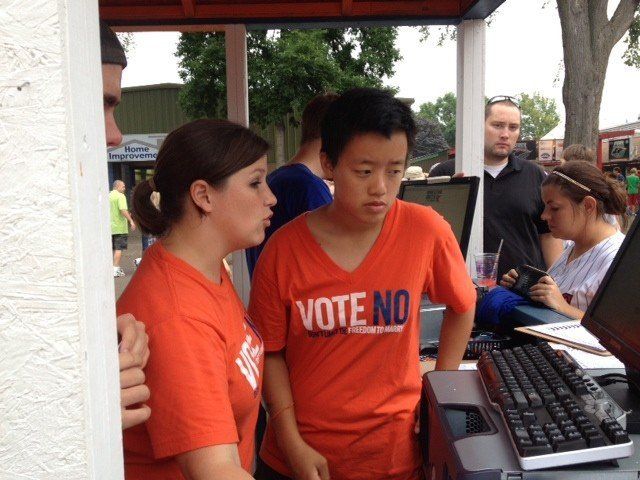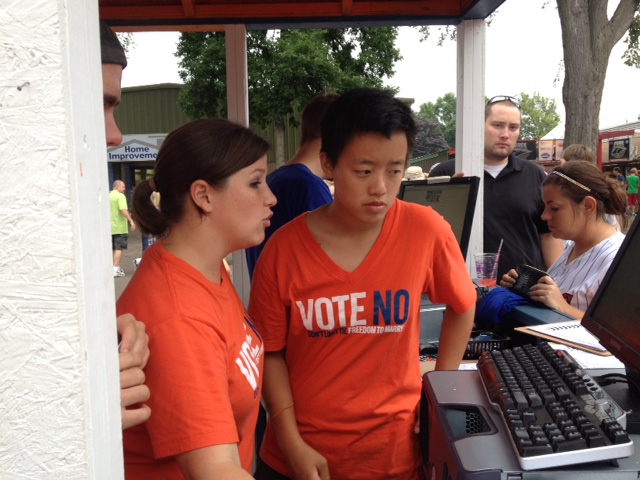
 The most basic act of voter education and persuasion that I incorporate into daily life as the anti-gay-marriage amendment approaches in Minnesota is to walk around in a T-shirt that says, "Vote No: Don't Limit the Freedom to Marry."
The most basic act of voter education and persuasion that I incorporate into daily life as the anti-gay-marriage amendment approaches in Minnesota is to walk around in a T-shirt that says, "Vote No: Don't Limit the Freedom to Marry."
Based on my experiences, here are 10 pointers on how this shirt can have the greatest effect on voters. If you have ideas from wearing your own shirt, I'd love to hear them!
1. Wear the shirt with love and kindness. Put it on as an act of courage, but also as an act of connection to people. Though the shirt declares "Vote No" in bold letters, folks will pick it up if they feel that you are saying "no, thank you!" as opposed to, "hell no!" Undecided voters will not be drawn to talking to you if they read you as saying "hell no!" It's Minnesota. People like to think we are nice.
2. Smile at people when you wear it. Expect them to offer you support. Occasionally people will glare at you, or worse. Keep smiling. Don't fight with them.
3. Wear it places where people have a chance to talk to you: at the dog park, waiting in line, at PTA meetings, at the gym. Allow time for conversations about it.
4. Allow people to come to you. Sit back. Don't thrust your chest in people's faces. If you are gentle and allow space, many of them will approach you.
5. In my experience, the most common thing that people will say to you is that they don't understand the amendment. What precisely does a "no" vote mean? I have found that the easiest thing to say is, "A 'no' vote means, 'No, don't change our constitution.'" And then I add, "I tell myself, 'No-vember!'" I avoid saying or implying things like, "A 'no' vote means you are not a homophobic jerk." I offer the answer in a neutral tone.
6. If they are quiet but remain close by, I'll ask them, "Have you considered how you are going to vote on this amendment?"
7. If they say, "I'm definitely going to vote against it! I am very upset that it is on the ballot," I say, "Do you know that unless people like you and I have thousands of conversations between now and the election, we are going to lose the vote?" Engage them in how they might have conversations. Encourage them to do canvassing or phone banking, or to go to a training to role play difficult conversations with people they know. Ask them who they might talk with who is undecided. Talk to them about being nonjudgmental, and personal.
8. If they say, "I'm just not sure," I ask, "Would you like to hear why I am voting against it?" And I say that softly, again, invitingly. They may say, "Not really," in which case I smile and say, "Good luck with your own decision making," and don't force myself on them. This in turn may lead them to say, "Aww, go ahead then." At this point, I speak personally and from the heart about how this amendment tells my family that we are not as good as others, that we are not welcome in Minnesota, that I am hurt by this vote, as is my child. I speak my own story, using words about pain and hurt. I speak my emotional truth, which they can't argue with, rather than trying to convince them with facts.
9. If they say, "I'm for sure voting for it. Marriage is between one man and one woman," or something like that, and they seem adamant, I don't argue with them. I just smile at them and say something like, "I hope someday you will change your mind on that." There aren't enough hours in the day to proof text the Bible or argue about what is bigotry and what isn't.
10. However the conversation has gone, I give myself a secret invisible pat on the back for having it, for staying true to myself, for not losing it or getting my buttons pushed. If someone was mean to me, I shake or walk it off, maybe talk to someone about it, and pet my dog if I'm at the dog park. I restore equilibrium so that I'm ready for the next moment when my shirt might be a catalyst for changing votes!
If I'm out in the garden for hours on end, yard signs can also allow conversations to take place. Shirts are a lot more personal than yard signs, though. And, bumper stickers... I don't know how to turn those into voter education and persuasion!
